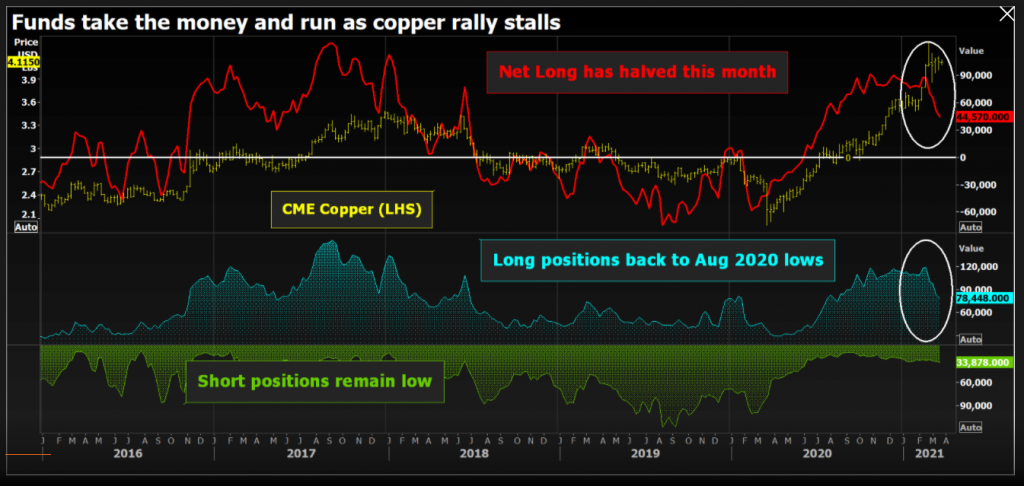Home: Funds take the money and run as copper price rally stalls
London Metal Exchange (LME) copper hit a near-decade high of $9,617 per tonne last month, at which stage the price had more than doubled from its March 2020 lows.
However, copper has subsequently churned sideways in often volatile and low-liquidity conditions, LME three-month metal currently trading around the $9,100 level.
Many of those who got in early on the rally have evidently decided to book some profits, with fund long positioning on the CME copper contract falling sharply this month.
Investors have been drawn to other markets, particularly a resurgent energy sector, but the outflow of funds also reflects wariness about the potential for a major correction as the market’s short-term optics start to look a bit less bullish.

Take the money
As of last Tuesday money managers were collectively net long of the CME copper contract to the tune of 44,570 contracts.
The collective bull bet has almost halved in the space of a month from a February 14 high of 87,671 contracts and is now back at levels last seen in July last year, when the copper rally was in its infancy.
The shift in money manager positioning has been mainly down to a reduction in outright long positions from February’s three-year high of 118,463 contracts to a current 78,448.
Outright short positions have edged only marginally higher over the same time-frame, suggesting few are yet bold enough to take a fully contrarian stance to copper’s bull narrative.
The CME contract is heavily populated with black-box funds tracking price momentum, so it’s no surprise to see some exiting as the price action becomes more ambiguous.
But the scale of the reduction suggests that technical signals are not the only driver.
So too with LME broker Marex Spectron’s assessment that speculative length in the LME contract has collapsed from 62% of open interest at the end of February to around 36%.
Marex has highlighted for several weeks the rotation of investment money out of metals into other sectors, energy in particular.
But copper hasn’t been helped by shifts in its own micro dynamics, particularly the recent build in visible stocks.
Changing optics
Everyone still likes copper’s longer-term bull narrative, centred on constrained supply and rising demand from decarbonisation.
But short-term optics, particularly on the London market, look less bullish than a few weeks ago.
LME inventories have been rising from the extremely low levels seen in the first two months of the year.
It’s quite possible that funds will pivot back towards metals in the near future
Registered inventory totalled a meagre 74,200 tonnes at the end of February, with the LME’s benchmark cash-to-three-months timespread flexing out to a backwardation of $70 per tonne in early March. That was the highest cash premium since March 2019.
The market was signalling extreme physical tightness, which appeared to tally with the continued strength of China’s copper imports.
But copper stocks had been quietly building in the LME shadows over the back end of 2020 and some of that metal has this month been moved onto the official stocks. The headline figure is now at a year-to-date high of 113,900 tonnes.
Tightness in the spreads has accordingly abated, the cash-to-three-months backwardation contracting to $9 per tonne on Monday morning.
Inventory builds
With the hindsight provided by the LME’s lagging monthly off-warrant stocks reports, the market wasn’t nearly as physically tight as suggested last month.
Off-warrant copper stocks, denoting metal that is being stored with explicit contractual reference to potential LME warranting, increased by 67,600 tonnes between September and February.
They totalled 167,294 tonnes at the end of January, dwarfing the 74,275 tonnes of on-warrant exchange stocks.
Most of the “shadow” stock build took place in Rotterdam, which held 129,000 tonnes of copper at the end of January. The Dutch port has accounted for 46,375 tonnes of this month’s total arrivals of 54,025 tonnes.
The aluminum market has long stopped taking its cue from headline stock movements because of the heavy-volume movement of metal onto and off LME warrant.
The copper market might now have to start paying a little more attention to what’s going on in the storage shadows to get a more holistic view of LME inventory levels.
It will also have to factor in an entirely newly component of global visible exchange stocks.
The Shanghai Futures Exchange’s (ShFE) international copper contract, operated by subsidiary Shanghai International Energy Exchange (INE), has seven registered warehouses in Shanghai’s bonded zone.
INE inventory has grown from just 100 tonnes in January to 58,839 tonnes, capturing stocks previously obscured in the statistical twilight zone of China’s bonded warehouse zones.
These INE stocks are different from the ShFE’s own inventory, which is based on domestic, duty-paid metal.
This, by the way, has also been rising sharply over the Lunar New Year holiday period, and at 187,372 tonnes is now up by 100,000 tonnes on the start of January.
There suddenly seems to be a lot more copper around than was being projected by LME stocks and spreads just a month ago.
Which is one reason why the market has lost some of its bullish fire in the last few weeks, accentuating the profit-taking and rotation trends in the fund community.
It’s quite possible that funds will pivot back towards metals in the near future, but whether they’ll recommit to copper at current prices or await the widely expected dip remains to be seen.




